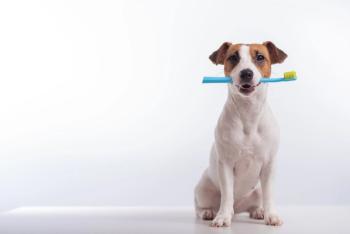
The flash glucose monitoring system: an invaluable tool for diabetic cats and dogs
FGMS may help enhance at-home care and the overall management of veterinary diabetes
Though diabetes is common in canine and feline medicine, its management is often complicated. It requires veterinarians and pet owners to coordinate their efforts to provide diabetic care both in the hospital and the patient’s home.
The mainstay of treatment for feline and canine diabetes is insulin alongside dietary modification. The veterinarian usually performs in-hospital blood glucose curves to initiate insulin, and repeats them:
- after the first dose of a new kind of insulin
- at 7 to 14 days after an insulin dose change
- at least every 3 months in a well-controlled animal with diabetes
- any time clinical signs recur in a controlled patient, and
- when hypoglycemia is suspected.
This can burden both the owner and the animal with frequent veterinary visits, the cost associated with each visit, and costs and stress related to hospitalizing the pet for 10-12 hours each time. Cats (more often than dogs) may develop stress hyperglycemia in the hospital setting.1
At-home portable blood glucose meters can alleviate some of this burden but come with their own challenges. Needing more than 1 puncture to obtain a blood drop, not obtaining sufficient blood volume from the puncture, needing assistance in restraining the pet, and the pet’s resistance to obtaining the blood sample are all common issues.2
Continuous glucose monitoring systems (CGMS) differ from portable blood glucose meters in that they use a sensor applied to the surface of the body to measure interstitial glucose concentration. However, capillary blood samples are still required to calibrate the device. The newest advancement in at-home blood glucose monitoring is the flash glucose monitoring system (FGMS), which similarly measures interstitial glucose levels through a sensor on the skin and can be worn for up to 14 days. The most widely used device is the Freestyle Libre, which provides glucose levels every minute directly to the monitor or to a smart phone. These systems do not require capillary blood glucose samples for calibration.
Determining the accuracy of FGM systems in veterinary patients is an important determinant of their use in clinical practice. One study measuring the accuracy of FGMS in dogs found that when looking at IG in hypoglycemic, euglycemic, and hyperglycemic subgroups, the values were 93%, 99%, and 99% accurate respectively, compared with capillary blood glucose reference values. It demonstrated FGMS to be accurate overall, but with slightly less accuracy when looking at blood glucose values in the hypoglycemic range.3
Another study looking at FGMS in cats found similar results, with all IG readings being 99.4% accurate compared to reference ranges. One limiting factor identified in this study is that 70% of the sensors spontaneously stopped working after a median of 8.3 days before having to be replaced, and only 20% of sensors reached a period of 14 days as specified for human use. In both studies of cats and dogs, mild erythema at the site of the sensor was noted, most likely due to the adhesive surface.3,4
Overall, FGMS show promising use in the at-home management and overall care of diabetic veterinary patients.
References
- Behrend E, Holford A, Lathan P, Rucinsky R, Schulman R. 2018 AAHA diabetes management guidelines for dogs and cats. J Am Anim Hosp Assoc. 2018;54(1):1-21. doi: 10.5326/JAAHA-MS-6822
- Van de Maele I, Rogier N, Daminet S. Retrospective study of owners’ perception on home monitoring of blood glucose in diabetic dogs and cats. Can Vet J. 2005;46(8):718–23. PMID: 16187716.
- Corradini S, Pilosio B, Dondi F, et al. Accuracy of a flash glucose monitoring system in diabetic dogs. J Vet Intern Med. 2016;30(4):983-988. doi: 10.1111/jvim.14355
- Deiting V, Mischke R. Use of the “FreeStyle libre” glucose monitoring system in diabetic cats. Res Vet Sci. 2021;135:253-259. doi: 10.1016/j.rvsc.2020.09.015
Ghatpande is a 2022 PharmD candidate at the University of Connecticut
Newsletter
From exam room tips to practice management insights, get trusted veterinary news delivered straight to your inbox—subscribe to dvm360.




